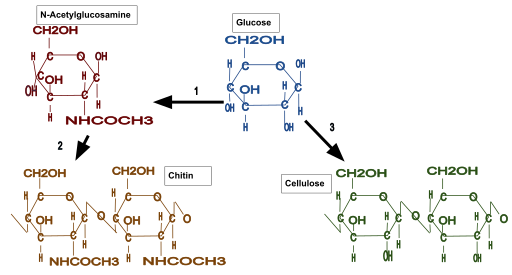File:Chitin glucose and cellulose.svg

Original file (SVG file, nominally 512 × 274 pixels, file size: 290 KB)
Captions
Captions
Summary[edit]
| DescriptionChitin glucose and cellulose.svg |
English: 1.The transition between glucose and N-Acetylglucosamine 2. The polymerization of N-Acetylglucosamine to chitin 3.The polymerization of glucose to cellulose. Glucose changes depending on what form it takes, glucose is the basis of both chitin and cellulose and the only difference between the two types is what form glucose takes in each polymer. When it becomes chitin it changes to N Acetylglucosamine which then gets polymerized into chitin. Glucose remains the same when it becomes cellulose and only needs to get polymerized to become cellulose.
Cellulose Chitin |
| Date | |
| Source |
{{ https://www.chemistryworld.com/podcasts/chitin/6478.article https://www.ncbi.nlm.nih.gov/pubmed/21700357 https://en.wikipedia.org/wiki/Cellulose https://en.wikipedia.org/wiki/Chitin https://www.researchgate.net/figure/230575280_fig1_Fig-1-From-the-cellulose-sources-to-the-cellulose-molecules-details-of-the-cellulosic }} |
| Author | Arion422 |
Licensing[edit]
- You are free:
- to share – to copy, distribute and transmit the work
- to remix – to adapt the work
- Under the following conditions:
- attribution – You must give appropriate credit, provide a link to the license, and indicate if changes were made. You may do so in any reasonable manner, but not in any way that suggests the licensor endorses you or your use.
- share alike – If you remix, transform, or build upon the material, you must distribute your contributions under the same or compatible license as the original.
File history
Click on a date/time to view the file as it appeared at that time.
| Date/Time | Thumbnail | Dimensions | User | Comment | |
|---|---|---|---|---|---|
| current | 18:59, 23 May 2017 |  | 512 × 274 (290 KB) | Arion422 (talk | contribs) | update to image to make it much clearer |
| 16:14, 23 May 2017 |  | 512 × 279 (259 KB) | Arion422 (talk | contribs) | User created page with UploadWizard |
You cannot overwrite this file.
File usage on Commons
There are no pages that use this file.
File usage on other wikis
The following other wikis use this file:
Metadata
This file contains additional information such as Exif metadata which may have been added by the digital camera, scanner, or software program used to create or digitize it. If the file has been modified from its original state, some details such as the timestamp may not fully reflect those of the original file. The timestamp is only as accurate as the clock in the camera, and it may be completely wrong.
| Width | 100% |
|---|---|
| Height | 100% |